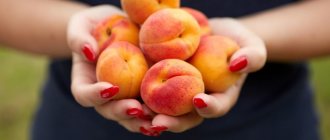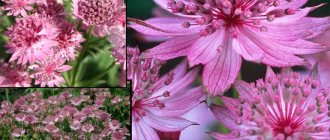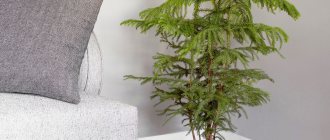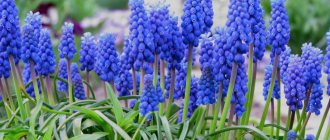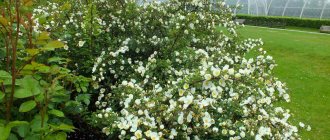Description and features of delphinium
Generally a tall, erect plant with heavily lobed leaves. Only alpine species are low.
Flowers often consist of 5 sepals, one of which is curled into a cone and slightly curved, which resembles a spur. In the middle there is an eye, different from the main flower, usually darker. Inflorescences of all shades.
The features of the spur are used in landscape design, covering unsightly areas of the site or in the background of a mixborder. Larkspur also looks great in single plantings, for example, in the middle of a lawn.
Diseases and pests
This crop can be attacked by the following insect pests:
- Delphinium fly (phorbia). It lays eggs in the middle of the bud, and its larvae then completely eat the flower from the inside. Spraying with special preparations (Iskra, Prometrin, etc.) helps.
- Slugs. Young plants are especially affected by them. Superphosphate or lime is scattered over the flowerbed, and traps are set and insects are collected manually.
- Aphid. The plantings are sprayed with tobacco or garlic infusion and pollinated with ash. In case of severe damage, insecticidal agents are used.
- Spider mite. Acaricidal drugs are used (Fitoverm, Actellik, etc.).
Main types and varieties of delphinium
There is a wide variety of natural, cultivated species and varieties of delphinium. They are annual (about 40 species) and perennial (about 300).
Annual delphinium
Annuals bloom much earlier than perennials (July), and continue to bloom until the end of September.
| View | Description | Leaves | Flowers |
| Field | Branched, erect, pubescent, up to 80 cm. | Trifoliate with linear lobes. | Up to 4 cm in all shades of blue, collected in brushes with curved spurs up to 2.5 cm. |
| High | Up to 3 m, erect, frost-resistant. | Fleecy, palmate, green, 15 cm, round. | Numerous, ultramarine, up to 60 pieces, with an open rim. |
| Large-flowered | Branched, erect, pubescent, up to 80 cm. | Trifoliate with linear lobes. | Up to 4 cm in all shades of blue, collected in brushes with curved spurs up to 2.5 cm. |
| Ajax | Up to 110 cm, straight, branched. | Sessile, strongly dissected. | Various colors. |
Perennial delphinium: New Zealand and others
Perennial delphiniums are hybrids obtained by crossing annual crops. They have more than 800 shades.
The flowers are double and simple, the height depends on the variety.
| View | Description | Leaves | Flowers |
| New Zealand | Plants 2 m. Frost-resistant, disease-resistant. Used for cutting. Varieties: Giant, Roksolana. | Wide green leaves. | Terry, semi-double (about 9 cm). |
| Belladonna | Height 90 cm. Sometimes blooms twice a year. Varieties: Piccolo, Balaton, Lord Battler. | Green, of 7 segments. | Blue, purple inflorescences of small 5 cm flowers. |
| Pacific | Tall, herbaceous, up to 150 cm. Varieties: Lancelot, Blue Jay, Summer Skies. | Large, heart-shaped, dissected. | 5 sepals, 4 cm, indigo, with black eye. |
| Scottish | Up to 1.5 m, erect. Varieties: Flamenco, Moonlight, Crystal Shine. | Dissected, large. | Super double, more than 60 petals of all colors of the rainbow, brushes up to 80 cm. |
| Beautiful | 1.8 m, erect, pubescent, leafy. | Finger-shaped, cut into 5 parts, serrated. | Blue, petals 2 cm, dense, black center, dense brushes. |
| Marfinsky | Decorative, frost-resistant, tall. Varieties: Morpheus, Blue lace, Pink sunset, Spring snow. | Large, dark. | Semi-double, large with bright core |
Description of the plant
Larkspur, spur, delphinium (Delphinium) - all these are names of one plant. The herbaceous flower can be either perennial or annual.
Delphinium belongs to the Buttercup family and has about 450 species . Annuals are classified into a related genus called Sokirki (Consolida), which includes about 40 species.
The natural range of the spur is extensive; it can be found throughout the northern hemisphere on the edges of forests, clearings, along the banks of streams and rivers. Many varieties of larkspur are native to Southeast Asia.
Attention! Delphinium is closely related to the poisonous family Aconite and, like them, is poisonous.
The height of the plant ranges from 0.8 to 1.2 m, but the low-growing alpine delphinium does not grow higher than 10 cm.
The stem of delphinium is oriented strictly upward, rigid, unbranched. Depending on the variety, it may have pubescence or be smooth.
The leaf plates of the plant are palmate-pinnate, planted on thick petioles opposite each other in such a way that they form a kind of rosette. The edge of the leaf has pronounced serrations. The root system of the spur is developed, the root itself is thick and fibrous.
During flowering, the delphinium opens many buds , forming a long (sometimes up to 1 meter) flower cluster.
There is an opinion that when closed, the buds of the spur are similar to the head of a dolphin, which served as the basis for the name. According to the second version, the flower was named after the Greek city of Delphi, where it grew in huge quantities.
its second name - “spur” - due to the long transverse process on the sepals, which resembles a spur.
The color of the buds is strikingly diverse. Main shades:
- white;
- blue;
- blue;
- pink;
- yellow;
- violet.
The corollas are found in both rich and pastel colors, and the hybrid delphinium can have a two-color color.
Flowering begins in June-July and lasts until the end of September . Cultural delphinium - honey plant; has simple, semi-double or double flowers. They attract a large number of butterflies and bumblebees to the site.
Growing delphinium from seeds: when to plant
Delphinium seeds lose their viability very quickly, so purchased ones sometimes do not germinate at all.
Many gardeners prefer to collect their seeds and then use them to germinate plants.
- They are stored in the refrigerator until planting.
- Sowing is carried out in February.
- The planting material is disinfected by placing it in a pink manganese solution for half an hour or treating it with a fungicidal preparation.
- Rinse with cold water. Treat for 24 hours with a growth stimulator.
- Prepare a soil mixture of peat, garden soil, humus and sand, in a ratio of 2:2:2:1.
- The soil is calcined to destroy pathogenic microbes and weed spores.
- The containers are treated against microorganisms with the same means as seeds and filled with soil.
- Sow delphinium seeds over the surface. Cover with 1.5 centimeters of soil. Compact the soil. Carefully water the plantings.
- Cover with plastic film, glass or spunbond, and then with a dark covering material that does not transmit light.
- Place boxes with seeds on the windowsill. Growth temperature +10…+15 ºC.
- To increase germination, stratification is carried out by placing the plants on a closed balcony for 14 days. Return the boxes to the windowsill.
- Inspect the pots periodically. If the soil is dry, spray it. If it is wet, ventilate it to prevent rot.
- After 1-2 weeks, after the first shoots appear, the protective materials are removed, giving the plants access to light.
- When 3 true leaves appear, the seedlings are thinned out. Excess plants are transplanted into pots with a diameter of 9 cm.
- Water once a week or when the soil is dry, avoiding waterlogging.
- During seedling growth, root fertilizing with mineral fertilizers is carried out every 14 days.
In the first week of May, the plants are taken out to a glassed-in loggia and placed in a bright place. The balcony is periodically ventilated to accustom the seedlings to fresh air.
If the flower boxes are already at the dacha, they are placed near a warm wall and covered with spunbond. At the end of spring, the seedlings are transferred to open ground using the transshipment method so as not to disturb the root ball.
How to propagate delphinium by seeds: planting and care when growing seedlings
During seed propagation, parental properties are not transmitted, so you yourself will become a breeder and may well obtain hitherto unknown varieties. Freshly collected seeds (they ripen in August, for this you need to leave the faded clusters on the stems) are immediately sown in the greenhouse. Shoots appear in the fall and can freeze in the spring, so they should be covered with spruce branches for the winter. To avoid fussing with this, it is better to sow the seeds right before winter (late November). In the spring, seedlings appear; when growing delphiniums, seedlings should be planted 2-3 plants into one container or thinned out according to a 10x10 cm pattern and planted in place in August according to a 40x40 cm pattern.
Then expose it to light in a warm room. There is a nuance. Since delphinium seeds are very small, they are not sprinkled with soil when sowing. The moistened soil is compacted, the seeds are scattered over the surface and covered with film until shoots appear. Or, when sowing seedlings at home in March, snow is added to the soil surface in containers and the seeds are sown on the snow. Once melted, it will draw the seeds halfway into the soil.
To grow delphinium seedlings from seeds, place the container in a plastic bag and tie it. The seedlings are watered through a syringe, the needle of which is inserted into the ground. When growing flowers from seeds, when the delphiniums grow and begin to fall to one side, you need to rake the soil to them with a match.
When the frosts have passed, when caring for delphiniums, the seedlings can be moved either to the school until next spring, or directly to the place
But here it is important not to let the weeds clog them or the soil to dry out
Planting delphinium in open ground
Before planting, prepare the soil by digging and adding humus or manure. Then planting holes are made at a distance of 80 cm, fertilizers are placed in them, for example, ammonium nitrate.
Plants are transferred from pots, being careful not to damage the roots. Water and mulch the soil with sawdust or dry grass.
For a more secure fit, tie it to a support. 3 sticks for each bush are sharpened and driven into the ground beyond the roots. They are tied with not very wide ribbons or cloth.
Wire is not used, as it can damage the flower stems.
Preparation of materials
In order to grow seedlings, you will need seeds and soil of a certain composition. Growth stimulants will also help, as they will make the stratification process more successful.
Stratification
In order for the plants to grow well-developed, luxurious flowers, it is recommended to properly prepare the seeds. For this:
- Prepare a disinfectant solution from potassium permanganate or fungicide (Fitosporin, Maxima), diluted with water according to the instructions in the instructions.
- Place the seeds in a fabric bag and immerse it in the working solution for 20 minutes.
- Take it out and rinse off the remaining disinfectant liquid under running water.
- Place on a small plate and soak in settled water. There should not be too much liquid; 2-3 drops of a growth stimulator (Zircon, Epin) must be added to it.
- After one day, drain the liquid and place the seed material on a damp cloth in a thin layer.
- Roll the fabric and place it in a plastic container.
- Place the container in the refrigerator and periodically add 10-20 ml of water to it. It should only cover the bottom of the fabric roll. If there is too much liquid, the seeds will rot.
- An alternative to water is wet moss, which is used to transfer fabric rolls with seeds, after which the material is placed in the refrigerator.
- Stratification lasts a week, and when the embryos hatch, move the workpiece to the windowsill and keep it under phytolamps for a couple of days.
- Plant the germinated delphinium in an open area or in containers filled with fertile soil.
The described method is suitable for planting seedlings in February and is designed for growing at home.
Another way to prepare seeds:
- Soak the seed in early spring and wrap it in gauze.
- Place in a plastic bag.
- Bury it in the ground.
- After 1-2 weeks, remove and plant in the ground.
The best time for this method is April, when the snow begins to melt. Temperatures can range from –5–10 to +3–6° C.
Priming
Planting perennial delphinium requires preliminary soil preparation. You need to take garden soil and mix it with peat and humus in equal proportions. It is recommended to add a small amount of perlite to the mixture (0.5 cups per 5 liters of soil) to make the soil structure more loose. This will also help retain moisture in the soil.
Preliminary soil preparation includes not only the creation of a fertile substrate, but also its steaming for the purpose of disinfection. The procedure is carried out using a steam bath for one hour. Such soil will be completely safe for seed.
Delphinium care
Spurs are cared for like other flowers. Periodically loosen the soil and remove weeds. When the plants reach a height of more than 30 cm, the bushes are broken off, leaving the strongest stems. The weak ones are thrown away, and cuttings are cut from others and germinated. The process of removing weak shoots allows you to ventilate the bush to avoid infection with gray mold and fusarium. Then they tie it up after 40 cm. Water it every week, pouring out 3 buckets of water. Then, when the soil dries, it is hilled up.
Delphinium is periodically checked for diseases, as powdery mildew may appear during humid summers.
To avoid troubles, potassium and phosphorus fertilizers and fungicides are applied.
Delphinium after flowering
To achieve constant annual flowering from the plant, plantings are replanted, thinned and rejuvenated every 3 years.
In autumn, after the leaves turn yellow, the delphinium is cut off, leaving 30 cm of stems. The cut is covered with clay or ash so that water does not get into the hollow tubes of the stems. Less cold-resistant varieties are covered.
Delphinium annual or larkspur
Delphinium, or larkspur, is used for medicinal purposes as it has beneficial properties. It is found in fields, weedy places and fallow lands.
What does a delphinium look like?
Origin and appearance of annual plants
The flower may have received its name for its resemblance to the body of a dolphin. The stem has a paniculate-branched appearance. The length of the plant is 15-50 cm. The leaves are cut into narrow segments. The cuts can be double or triple. The flowers have an irregular shape. The petals are colored blue, pink or white. The fruit is a leaflet with gray seeds. Flowering occurs from early summer to autumn.
In Russia, it is common in the steppe and forest-steppe zones: Kazakhstan, Siberia and the Urals, Crimea. Delphinium is especially common in Kerch. It is grown as an ornamental plant in public gardens and gardens.
Delphinium is a poisonous plant. It contains poisonous elatin, eldelin, etc. They hit in three directions: the nervous, digestive and cardiac systems. Some herbivores fail to avoid the plant and die.
Delphinium propagation
Annual varieties are obtained by seedling method. Perennials can be propagated by cuttings or dividing the bush.
Cuttings
Cuttings are cut with a heel, the cut is treated with a growth stimulator Kornevin or Zircon. A mixture of sand and peat is prepared in planting boxes. Place the cuttings at an angle to the surface of the earth, moisten the soil and cover with film or covering material. Cuttings take up to 6 weeks to root. And then they wait another 14 days and transplant the sprouted plants into flower beds.
Dividing the bush
Held in August. Four-year-old bushes are selected for division. They are dug up and a cut is made with a sharpened knife. The cut is sprinkled with ash or a growth stimulant. Then they are buried in a permanent place, following the planting rules.
Delphinium perennial: sowing with seeds
Delphinium has such a property as self-seeding, but this is only if you already have this wonderful flower growing in your garden. What if it doesn't grow? Then we try to grow it ourselves.
Delphinium can be propagated by seeds, division of rhizomes and cuttings. Today we will look at sowing and growing delphinium from seeds.
Selection of seed material
At a temperature of -16°, the seeds will remain viable for up to 16 years. But the trouble is, there is no 100% certainty that the seeds purchased in the store were stored correctly.
After all, after lying for 9-11 months at room temperature, seed germination drops to 15-20%.
Large seeds germinate better than small ones. Light seeds germinate faster than dark ones.
Optimal timing for sowing seeds
In order for this perennial flower to bloom in the first year, we plant through seedlings at the end of March, April and May.
But if you want to get flowers in the summer, then you should sow the seeds a month or a month and a half earlier.
Delphínium perennial blooms 4 months after germination.
Preparing soil for growing delphinium from seeds
Add wood ash to the soil to reduce acidity.
Add vermicompost and perlite (or sifted sand).
It is advisable to water the soil with a solution of phytosporin two weeks before sowing.
To prevent waterlogging, place drainage at the bottom of the container: 1 cm of vermiculite. Fill the container 3/4 full with soil.
Preparation and treatment of delphinium seeds before planting
We remember that delphinium seeds stored at room temperature lose their viability after 11 months of storage.
Let's try to revive them.
Freezing
With strong cooling, seed germination is activated.
To do this, place the dry seeds in the freezer for several days.
Stratification
Stratification is carried out after sowing the seeds. To do this, containers with sown seeds should be placed in the refrigerator for two weeks.
Scarification
To improve germination, scarification is used, i.e. breaking the integrity of the hard shell; for this, carefully rub the seeds on sandpaper.
Sowing delphinium seeds for seedlings
Before sowing, we disinfect the selected seeds.
Place the seeds in a hydrogen peroxide solution for 3 minutes.
To speed up germination, treat the soil with very hot water. We spill the seeds spread out on the soil with hot boiled water.
The seeds will not be damaged. While we are pouring water from the kettle into the watering can and upon contact with the ground, the temperature of the water drops sharply.
We sow delphinium seeds thickly. For 1 sq. cm 2 seeds. The thicker the better.
To arrange the seeds in equal rows, place them on the snow located on top of the soil in the sowing container.
There is no snow, we use thin toilet paper.
Sprinkle the seeds on top with sifted calcined sand with ash or perlite. And put it in the refrigerator for 2 weeks.
Mr. Summer resident warns: delphinium diseases and the fight against them
With good care and favorable weather conditions, the spur tree pleases its owner with lush flowering.
But there are periods when yellow leaves or spots appear on the plant, and it dries out. Then the flower is checked for diseases and treated.
- Aster jaundice is carried by insects. Sick plants are removed.
- Ring spot. Leaf death and growth retardation are observed. Insects that carry the disease and affected leaves are removed from the bush.
- Black spot develops in cool, damp weather. Diseased parts are destroyed, and debris around the plant is removed in the fall.
- Bacterial wilt causes the lower part of the stem to turn black and produce mucus. Occurs from improper planting of seeds. Before germination, the seeds are kept in hot water.
Rules of agricultural technology
If the gardener wants to contemplate flowering in the year of planting, the seeds should be planted in mid-March - early April. A mandatory condition for storing seed is to use seeds that are no more than 1 year old; they must be stored in the refrigerator, otherwise they will lose their viability. Containers used for growing seedlings must be sterilely clean. Seeds usually germinate in 3-4 weeks.
Delphinium annual blue
Algorithm for planting seeds for seedlings:
- To disinfect seeds, it is necessary to soak them for 20 minutes in a solution of potassium permanganate (manganese). Dry.
- Select containers that are deep enough and fill them almost completely with fertile soil. The most suitable soil for annual delphinium is slightly acidic, clayey.
- Distribute the planting material evenly over the surface of the ground and carefully sprinkle it on top in a thin layer. Moisten the soil generously.
- For active germination, you will need to darken the seedlings and cover the containers with glass, newspaper or polyethylene. The optimal temperature for germination is +14 degrees.
- It is necessary to ensure that the seedlings do not dry out and, conversely, do not experience excess moisture. To avoid damaging the plants, you need to water them from a tray or use a syringe without a needle.
- Plants must be ventilated every day, otherwise, due to the condensation formed, rotting may begin and fungal diseases will develop.
- At intervals of 3-5 days, remove the seedlings to fresh air for hardening. The duration of the walk is 20-30 minutes.
- When there is stable warm weather outside, plants can be transferred from home to open ground.
Until the plant is completely rooted in open soil, it will need to be covered with a plastic bottle or jar. With steady warming, the shelter is removed.
Caring for an annual delphinium
To ensure lush flowering, the gardener will need to carry out all agrotechnical measures.
Delphinium develops well with moderate watering. Excess moisture is no less destructive than deficiency. The crop needs to be watered under the root system, especially during periods of drought. At intervals of a week, you need to pour 2-3 buckets of water under the bush. After each watering, it is recommended to loosen.
The application of organic and mineral fertilizers is the most critical stage in growing annual delphinium. During the growing season, 3 feedings should be carried out. The first - when the height of the plant reaches 15 cm, the second - during the formation of buds, and the third - after flowering has completed. As complex mineral fertilizers, it is recommended to use preparations that include saltpeter, potassium chloride and superphosphates. They are evenly distributed around the circle around the trunk, slightly buried in the ground.
The annual delphinium is a beautiful plant that makes you fall in love with its unusual appearance and unpretentiousness. Even novice gardeners can grow it; it is enough to first familiarize themselves with all the rules for planting and caring for the crop.
Botanical description of the culture, precautions
Let's start the botanical description of the culture with this fact - in fact, delphinium is called tall larkspur. This is exactly how the Latin name of the flower Delphinium elatum is translated. The culture is popularly called spur. Belongs to the genus Ranunculaceae and includes more than 450 species distributed across all continents of the globe. The most decorative ones come from China and Southeast Asia. Almost all of them are potentially dangerous to human health, since absolutely all parts of the plant are poisonous.
Precautionary measures are the same as when working with plants of their genus Aconite. They are close relatives and contain similar toxic substances
Delphinium consolida, an annual species that is often grown in the garden, is poisonous and potentially dangerous to bees, cattle and humans. When planning plantings, flowers should be placed in such a way that they do not fall into the feed of dairy cattle or are in the path of honey-collecting insects. Milk from an animal that has eaten larkspur, and honey from a bee that has collected pollen and nectar from this flower, are potentially dangerous to humans. They cause acute poisoning.
Timing for planting seeds
Depending on the season in which delphinium seeds are planted, it is necessary to select the appropriate months. For autumn, this is, as already mentioned, October and November. If the seeds are planted in the spring, the optimal months are April or May. Well, if the seeds are planted in the summer, the suitable months are, as you probably already guessed, June and July.
However, even the choice of planting date is teeming with nuances. As, indeed, the whole process of growing delphiniums in general. Especially planting seeds and caring for them is an extremely difficult task. The first thing to do with freshly collected seeds is to stratify. This means they need to sit in the refrigerator, damp, for about two weeks before planting. The temperature should not rise above 5 and not fall below 3 degrees Celsius.
Be careful, because often the seeds begin to sprout already in the refrigerator. The earliest planting date is March, and even the end of February. At this time, the seeds are planted if you are planting them as seedlings. In this case, the emerging shoots must be illuminated.
The resulting seedlings must be picked very carefully. When performing this operation, they are incredibly easy to break, and therefore it is not recommended to make too sudden movements
When you plant your seedlings, make sure you keep them deep enough. This must be done until the first cotyledon leaf. However, all these troubles are relevant only if you decide to grow a truly rare variety, the seeds of which are very limited in quantity.
The varieties that are best propagated by seeds are those that have a very well-developed tap root. Such delphiniums do not take root well when transplanted. But when propagated by seeds, they grow well and develop a powerful root system.
In addition, delphiniums grown from seeds have exceptional cold resistance and quite lush inflorescences. On the other hand, when growing more common, ordinary and familiar varieties, there is no point in bothering so much.
It will be much more effective to plant seeds in open ground in late autumn. Even if some of them do not sprout, however, compared to rare varieties, the loss will be small. Moreover, already in early spring you will be able to pick up the sprouts and plant them in your holes.
When you propagate Delphiniums from seeds, a lot of seedlings grow, and therefore you have a huge choice. For example, some of them, especially those that turned out to be weak, can be completely eliminated as unnecessary.
When planting seedlings, it is necessary to maintain the distance between the holes. This is done so that neighboring Delphiniums do not compete with each other for nutrients and do not interfere with the development of each other's root systems. The optimal distance between adjacent holes is approximately a quarter of a meter.
When to sow delphinium for seedlings in 2020
Delphinium varieties are perennial and annual. Although the latter are less common, it is fair to consider the planting timing of both groups.
But in different regions, planting time varies, since there are different weather and climatic conditions:
- in the middle zone (including the Moscow region) it is better to sow in mid-March;
- in Siberia, the Urals, and the Leningrad region at the end of March;
- but in the South it is optimal to sow seeds at the end of February.
It will also help you choose the appropriate timing for planting delphinium seedlings.
Lunar calendar 2022:
Suitable days for annuals:
- in February -1, 2, 3, 4, 5, 6, 7, 8, 10, 11, 12, 13, 14, 15, 16, 17, 18, 19, 20, 25, 26, 27, 28, 29 number;
- in March - 2, 3, 4, 5, 6, 7, 8, 10, 11, 12, 13, 14, 29, 30, 31;
- in April - 1, 2, 5, 6, 7, 9, 18, 19, 20, 24, 25.
Suitable days for perennial culture:
- in February -1, 2, 3, 4, 5, 6, 7, 8, 10, 11, 12, 13, 14, 15, 16, 17, 18, 19, 20, 25, 26, 27, 28, 29 number;
- in March - 4, 5, 6, 12, 13, 14, 26, 27, 28, 29, 30, 31;
- in April - 1, 2, 5, 6, 7, 9, 13, 14, 24, 25.
Unfavorable days in 2022
- March - 1-3, 13-18, 30-31;
- April - 1, 9-11, 15-16, 29-30;
- May - 1, 7-8, 14-15, 28-31;
- June - 3-5, 12-14, 27-30;
- August - 10-11, 24-27;
- September - 8-10, 20-22, 24-26; October - 8-9, 17-19, 23-25.
